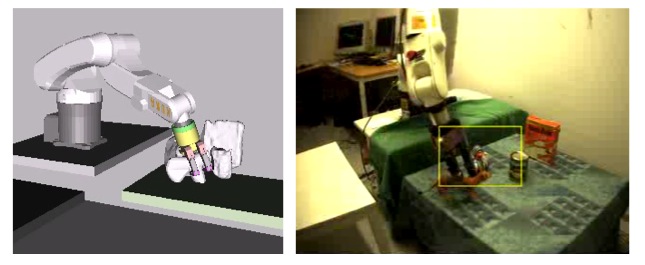Mind the gap - robotic grasping under incomplete observation

We consider the problem of grasp and manipulation planning when the state of the world is only partially observable. Specifically, we address the task of picking up unknown objects from a table top. The proposed approach to object shape prediction aims at closing the knowledge gaps in the robot's understanding of the world. A completed state estimate of the environment can then be provided to a simulator in which stable grasps and collision-free movements are planned. The proposed approach is based on the observation that many objects commonly in use in a service robotic scenario possess symmetries. We search for the optimal parameters of these symmetries given visibility constraints. Once found, the point cloud is completed and a surface mesh reconstructed. Quantitative experiments show that the predictions are valid approximations of the real object shape. By demonstrating the approach on two very different robotic platforms its generality is emphasized.
| Author(s): | Bohg, J. and Johnson-Roberson, M. and Leon, B. and Felip, J. and Gratal, X. and Bergstrom, N. and Kragic, D. and Morales, A. |
| Book Title: | Robotics and Automation (ICRA), 2011 IEEE International Conference on |
| Pages: | 686-693 |
| Year: | 2011 |
| Month: | May |
| Project(s): | |
| Bibtex Type: | Conference Paper (inproceedings) |
| DOI: | 10.1109/ICRA.2011.5980354 |
| Electronic Archiving: | grant_archive |
| Links: | |
BibTex
@inproceedings{5980354,
title = {Mind the gap - robotic grasping under incomplete observation},
booktitle = {Robotics and Automation (ICRA), 2011 IEEE International Conference on},
abstract = {We consider the problem of grasp and manipulation planning when the state of the world is only partially observable. Specifically, we address the task of picking up unknown objects from a table top. The proposed approach to object shape prediction aims at closing the knowledge gaps in the robot's understanding of the world. A completed state estimate of the environment can then be provided to a simulator in which stable grasps and collision-free movements are planned. The proposed approach is based on the observation that many objects commonly in use in a service robotic scenario possess symmetries. We search for the optimal parameters of these symmetries given visibility constraints. Once found, the point cloud is completed and a surface mesh reconstructed. Quantitative experiments show that the predictions are valid approximations of the real object shape. By demonstrating the approach on two very different robotic platforms its generality is emphasized.},
pages = {686-693},
month = may,
year = {2011},
slug = {5980354},
author = {Bohg, J. and Johnson-Roberson, M. and Leon, B. and Felip, J. and Gratal, X. and Bergstrom, N. and Kragic, D. and Morales, A.},
month_numeric = {5}
}
